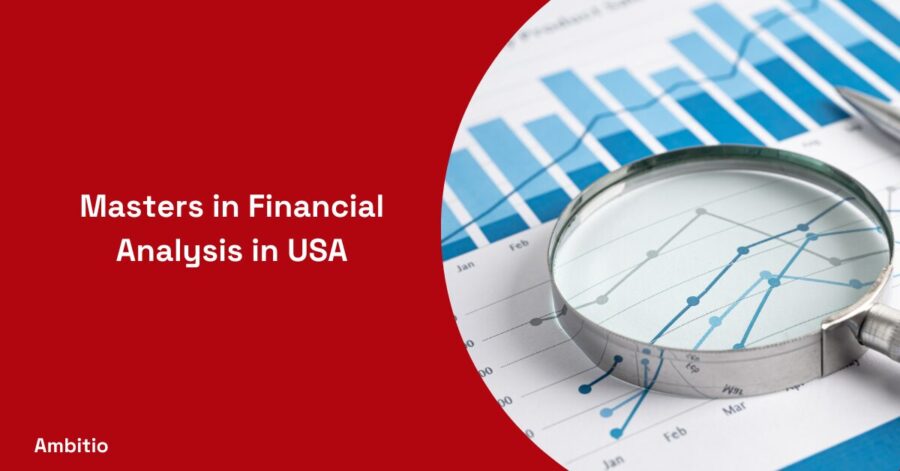11 December 2024
5 minutes read
Masters in Financial Analysis in USA

Key Takeaways
- A Master of Science in Financial Analysis in the USA provides a blend of finance and data science education.
- The program offers networking opportunities and opens career paths in various financial sectors.
- Top US universities offer this program with world-class faculty and comprehensive curricula.
The field of financial analysis stands at the forefront of guiding corporations and individuals through the complexities of the finance industry. Pursuing a Masters in Financial Analysis in USA equips students with the tools to excel in this dynamic field.
Financial analytics, a blend of finance and data science, has become increasingly vital in today’s data-driven world. In 2024, the demand for financial analysts in the USA is at an all-time high, offering a wealth of opportunities for those equipped with the right skill set.
Why Pursue a Masters in Financial Analysis in the USA?
The USA is home to many top-ranked public universities and colleges of business, making it a hub for advanced degrees in finance and analytics. A Master of Science in Financial Analysis from a US institution offers:
- World-class Education: Learn from distinguished faculty with industry experience in financial analysis, investment management, and corporate finance.
- Networking Opportunities: Engage with a diverse cohort of students, alumni, and professionals, fostering connections that can propel your career.
- Career Prospects: A degree in financial analytics opens doors to roles in hedge funds, wealth management, and investment firms, with a competitive median salary.
Top Universities for Financial Analytics in the USA
Exploring the top universities for Financial Analytics in the USA can help you identify the best programs that blend finance, data analysis, and technology, setting you up for a successful career in this rapidly evolving field.
| University | Program Name | Location | Duration | Tuition (approx.) | STEM Designated |
|---|---|---|---|---|---|
| MIT Sloan | Master of Finance | Massachusetts | 12 months | $80,000 | Yes |
| University of Chicago | Master of Science in Financial Mathematics | Illinois | 9 months | $66,000 | Yes |
| Stanford University | Master of Science in Financial Analytics | California | 18 months | $72,000 | Yes |
| University of Pennsylvania | Master of Finance | Pennsylvania | 18 months | $78,000 | Yes |
| Harvard University | Master of Science in Finance | Massachusetts | 12 months | $84,000 | Yes |
Program Structure and Curriculum
Understanding the program structure and curriculum of Financial Analytics programs is crucial to ensure they align with your career goals and provide the necessary skills and knowledge for success in the field.
| Component | Details | Typical Duration |
|---|---|---|
| Core Courses | Foundational courses covering topics like financial modeling, portfolio management, and risk management. | Varies by program |
| Electives | Specialized courses allow for focus areas such as quantitative finance, corporate finance, or investment banking. | Varies by program |
| Practical Experience | Hands-on projects and case studies to apply theoretical knowledge in real-world scenarios. | Throughout the program |
| Capstone Project | Comprehensive project synthesizing learned concepts, often involving real-world data and industry collaboration. | End of program |
| Internship Opportunities | Opportunities to work in finance roles, providing practical experience and industry exposure. | Summer or part-time during the program |
Admission Requirements and Process
Navigating the admission requirements and process for Financial Analytics programs can help you prepare effectively and increase your chances of securing a spot in a top university.
| Requirement | Details |
|---|---|
| Bachelor’s Degree | A completed bachelor’s degree in a related field such as finance, economics, or business. |
| Standardized Test Scores | Submission of GMAT or GRE scores, often with recommended score ranges. |
| Letters of Recommendation | Usually 2-3 letters of recommendation from professors or professionals who can attest to your qualifications. |
| Statement of Purpose (SOP) | A statement outlining your academic and career goals, why you’re interested in the program, and how it aligns with your aspirations. |
| Resume/CV | An updated resume or curriculum vitae (CV) detailing your academic and professional experiences. |
| Transcripts | Official transcripts from all previously attended institutions, showcasing your academic history. |
| Application Fee | Payment of the application fee varies by university and program |
Step-By-Step Application Process
Now that we have a clear idea of the admission requirements, here is a step-by-step guide of how to carry out the application process of the masters program:
Step 1: Research Programs and Universities
Begin by researching various programs and universities offering Masters in Financial Analysis. Consider factors such as program curriculum, location, faculty, and alumni network.
Step 2: Meet Admission Requirements
Ensure you meet the admission requirements, including having a bachelor’s degree in a related field and competitive standardized test scores (GMAT or GRE).
Step 3: Prepare Application Materials
Gather the required application materials, which typically include letters of recommendation, a statement of purpose (SOP), an updated resume/CV, official transcripts, and standardized test scores.
Step 4: Write a Strong SOP
Craft a compelling Statement of Purpose (SOP) that outlines your academic and career goals, your interest in the program, and how it aligns with your aspirations.
Step 5: Obtain Letters of Recommendation
Request 2-3 letters of recommendation from professors or professionals who can speak to your qualifications and potential for success in the program.
Step 6: Complete the Application Form
Fill out the application form for your chosen university or program. Ensure that all information is accurate and complete.
Step 7: Pay the Application Fee
Pay the application fee, which varies by university and program. This fee is typically required to process your application.
Step 8: Submit Your Application
Submit your completed application along with all required materials by the specified deadline. Be sure to follow the university’s submission guidelines.
Step 9: Prepare for Interviews (if applicable)
Some programs may require an interview as part of the admission process. If so, be prepared to discuss your background, goals, and interest in the program.
Step 10: Await Admission Decision
After submitting your application, wait for the admission decision. This can take several weeks to a few months after the application deadline.
Step 11: Acceptance and Enrollment
If you receive an acceptance letter, carefully review the terms and conditions of your admission. Follow the university’s instructions for enrollment, including payment of any required deposits or tuition.
Scholarships and Financial Aid
Exploring scholarships and financial aid options can make pursuing a Financial Analytics program more affordable, helping you manage the costs associated with higher education.
| Type of Aid | Details | How to Apply |
|---|---|---|
| Merit-Based Scholarships | Awards are based on academic, leadership, or other achievements. Examples: Dean’s Scholarship, Excellence Award. | Automatically considered with program application or separate scholarship application. |
| Need-Based Scholarships | Awards are based on financial need. Examples: Diversity Scholarship, Access Opportunity Scholarship. | Requires demonstration of financial need, usually through a separate application. |
| Fellowships | Grants for research or teaching, often with a stipend. Examples: Research Fellowship, Teaching Fellowship. | Application through universities or specific departments often requires a proposal. |
| Assistantships | Opportunities to work on campus in research, teaching, or administrative roles. Includes tuition waiver or stipend. | Application through the department or financial aid office may require interviews. |
| Loans | Federal and private loans to finance education. Examples: Federal Stafford Loan, Private Education Loans. | Application through federal aid (FAFSA) or private lenders. |
Conclusion
In conclusion, a Master of Science in Financial Analysis in the USA for 2024 offers an unparalleled opportunity to immerse oneself in the world of finance. This program not only provides technical skills in analytics and finance but also opens doors to a network of professionals and a career path with high growth potential.
Aspiring financial analysts are encouraged to research, connect with universities, and take the first step toward a rewarding career in this exciting field.
Unleash your full professional potential with Ambitio Pro. Our platform is engineered to foster your growth, offering tools for skill enhancement, leadership development, and strategic career advancements, ensuring you’re equipped to excel in today’s competitive landscape.
FAQs
What are the typical admission requirements for a Master’s in Financial Analysis in the USA?
Admission requirements usually include a bachelor’s degree, GMAT or GRE scores, a Statement of Purpose, Letters of Recommendation, and a resume.
How long does it take to complete a Masters in Financial Analysis program?
Most programs take one to two years to complete, depending on whether you enroll full-time or part-time.
What kind of career opportunities can I expect after completing this master’s program?
Graduates often pursue careers in investment banking, financial consulting, risk management, asset management, and corporate finance.
Are there scholarships or financial aid available for these programs?
Yes, many universities offer scholarships, financial aid, and work-study programs to help finance your education.
Can international students work in the USA after completing their Masters in Financial Analysis?
International students can apply for Optional Practical Training (OPT) to work in the USA for up to three years after graduation, especially if the program is STEM-designated.

You can study at top universities worldwide!
Get expert tips and tricks to get into top universities with a free expert session.
Book Your Free 30-Minute Session Now! Book a call now




























